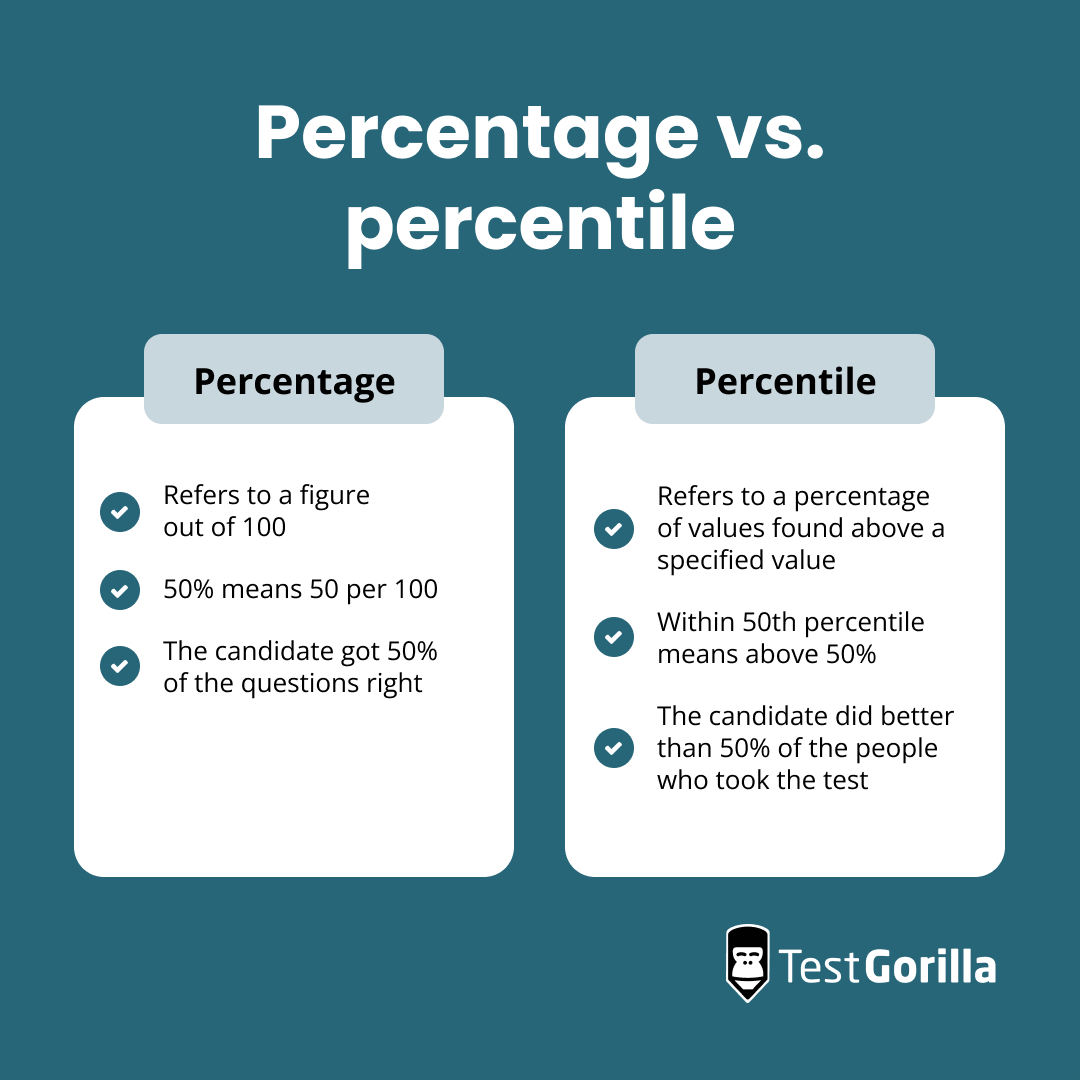The difference between percentages vs. percentiles (and why it matters)
Percentages and percentiles are important metrics that play a key role in helping you understand your shortlisting test results and what they mean for hiring the best candidate. Percentages are relatively easy to understand, as they are generally used to calculate a range of numbers in everyday life, while percentiles can seem more intimidating to people who are not mathematically inclined.
Find out why knowing the difference is important for understanding recruitment tests and how to distinguish between the two.
Table of contents
What is a percentage?
A percentage refers to a figure out of 100.
Therefore, 50% means 50 per 100. Percentages provide a simple way to standardize different quantities for comparison purposes; such as the ratio of desk chairs to desks on one floor of an office building, compared to the number of desk chairs to desks on a different floor of the building.
What is a percentile?
Most people are familiar with percentages and use them to calculate figures as they go about their day, such as calculating a college grade, bank interest rates, or how much we are saving on a sweater in a store sale.
However, most people don’t use percentiles frequently. So, what exactly is a percentile? A percentile refers to a percentage of values found above a specified value. In practice, if a score falls within the 70th percentile, then the person who took the test scored better than 70% of people who have taken the test.
Why are percentages helpful in pre-employment testing?
In pre-employment testing, percentages are helpful for comparing how well each candidate has performed. TestGorilla test scores reflect the percentage of questions answered correctly. Percentages are a quick and easy way to assess how well a candidate does on the test you’ve given them. Percentages also give you an easy way to compare two candidates.
Why are percentiles helpful in pre-employment testing?
Percentages often fail to illuminate how difficult a test is. If all of your candidates seem to have low scores on one of your tests, is it because the candidates aren’t skilled in that area or because the test is difficult? Percentiles help you answer that question by giving you an insight into how well each candidate performed in comparison to everyone else who has taken the test (not just the candidates you invited).
At TestGorilla, we provide a scoring benchmark that allows you to visualize your scores as percentile ranks. If the percentile rank score of one of your candidates is 75% on a particular test, then they’ve done better than 75% of candidates who have taken that test.
This calculated percentile goes beyond just the candidates you’ve sent to the test. We calculate the percentile by comparing every candidate who has taken the test with our customers. This gives you an accurate indication of how well a candidate performs in comparison to hundreds of other candidates with a similar skill set, as a percentile rank score normalizes for differences in the difficulty level of a particular test. As such, percentiles are integral to helping you identify how well a candidate has performed on the test you provided.
Then you can use the norm group of your choice to compare different candidates and set a cutoff score. To enable you to do this, we provide candidates with optional surveys on demographic questions, such as:
Their education level (from high-school to Master’s degree or higher)
Business function (think: marketing, administrative, finance, legal, management, operations, and other key areas)
Their seniority: Junior (up to 3 years of experience) or senior (4+ years of experience)
The percentage of questions they asked correctly (not specifically a norm group but helpful, nonetheless)
Go beyond the numbers
Percentages and percentiles are important in comparing candidates to their peers. They help develop deeper insights into a candidate’s abilities and mental acumen. However, percentages and percentiles aren’t everything. Someone could score lower on technical skill and be a better fit for your company.
For example, one candidate may thrive in a lively, face-paced office environment where regular meetings and collaborations are the norm. Alternatively, another candidate may do well in a more relaxed and slow-paced office, where autonomy is prized. One of these candidates could bring a lot to your team, while another could feel frustrated and underperform. Ensuring your new hire fits into your office culture is key for maintaining a high employee retention rate.
In addition, a candidate’s personality traits and attitude are just as important in how well they will do in the role―especially if it’s a client or customer-facing role, a managerial role, or one that requires a lot of teamwork. That’s why we recommend testing a range of character traits, soft skills, and attitudes to get a more holistic view of each candidate.
To get a full picture of a candidate, go beyond technical skills tests, and test for personality traits and attitude, here are the best TestGorilla tests for the job:
Culture add. This test assesses how a candidate’s values, behaviors, and interests fit with your company values, as well as the behaviors and activities that would help them succeed in their role.
16 personalities test. Inspired by the work of Carl Jung, the 16 types test provides you with information on a candidate’s personality preferences – such as introversion or extroversion and whether they are structured or more flexible and spontaneous.
DISC. Developed by William Marston, this test characterizes the expression of emotion – dominance (D), influence (I), steadiness (S), and conscientiousness (C).
Two calculations for measuring talent
Percentages and percentiles both play an important role in helping you screen for and hire the very best talent. While they are a great way to enhance the hiring process and help you distinguish between the strengths of a variety of different candidates, it’s important to go beyond the metrics and hire the best fit for your team by testing someone’s approach to work and personality traits.
Related posts
You've scrolled this far
Why not try TestGorilla for free, and see what happens when you put skills first.
Latest posts
The best advice on pre-employment testing, in your inbox.
No spam. Unsubscribe at any time.

Hire the best. No bias. No stress.
Our screening tests identify the best candidates and make your hiring decisions faster, easier, and bias-free.
Free resources
This checklist covers key features you should look for when choosing a skills testing platform
This resource will help you develop an onboarding checklist for new hires.
How to assess your candidates' attention to detail.
Learn how to get human resources certified through HRCI or SHRM.
Learn how you can improve the level of talent at your company.
Learn how CapitalT reduced hiring bias with online skills assessments.
Learn how to make the resume process more efficient and more effective.
Improve your hiring strategy with these 7 critical recruitment metrics.
Learn how Sukhi decreased time spent reviewing resumes by 83%!
Hire more efficiently with these hacks that 99% of recruiters aren't using.
Make a business case for diversity and inclusion initiatives with this data.


















